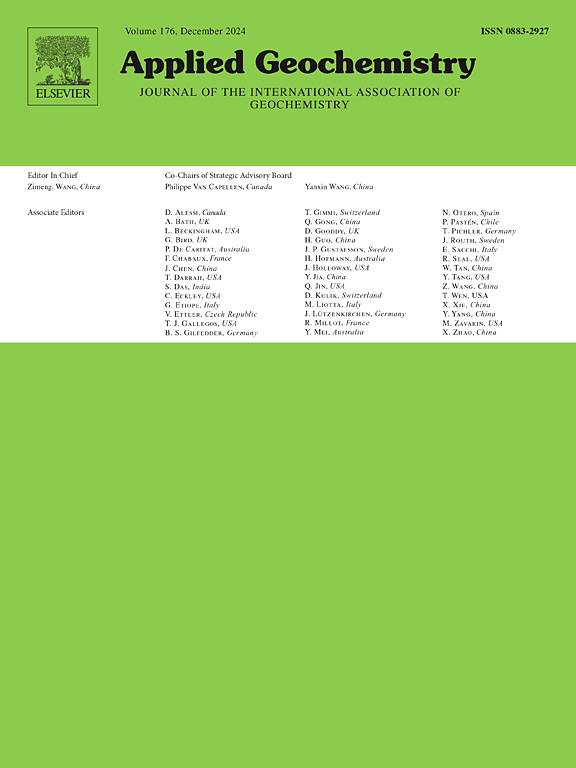Groundwater recharge sources analysis of coastal aquifer under the impact of cut-off walls: A case study of the Dagu River
IF 3.4
3区 地球科学
Q1 GEOCHEMISTRY & GEOPHYSICS
引用次数: 0
Abstract
Water quality degradation due to seawater intrusion is a globally significant environmental and geological issue. Cut-off walls, besides mitigating seawater intrusion, can alter groundwater flow direction and rate. Re-analysis recharge sources in coastal aquifers with cut-off walls is crucial for hydrogeological research and water resource management. Our study focused on the Lower Dagu River, where cut-off walls were installed. We employed the M3-MIX method to analyze groundwater recharge sources. The qualitative assessment revealed a substantial reduction in regional hydraulic connections across the cut-off walls, although weak seasonal connections persist due to groundwater level fluctuations and wall heights. Using M3-MIX, we identified four recharge sources in the south area—three salt groundwater sources and one saline surface water source—with mixing ratios of 1.4 %, 44.3 %, 41.8 %, and 12.5 %, respectively. In the north area, three recharge sources were identified—a river water sample, a saline surface water sample, and a groundwater sample—with mixing ratios of 14.9 %, 26.8 %, and 58.3 %, respectively. Our findings underscore the impact of cut-off walls on recharge sources and highlight the importance of re-analysis these sources for effective exploitation and protection of coastal aquifer water resources.
截流墙影响下沿海含水层地下水补给来源分析——以大沽河为例
海水入侵引起的水质退化是一个全球性的环境和地质问题。防渗墙除了可以减少海水入侵,还可以改变地下水的流向和流速。重新分析具有截流墙的沿海含水层补给源对水文地质研究和水资源管理具有重要意义。我们的研究集中在大沽河下游,那里设置了切断墙。采用M3-MIX方法对地下水补给源进行分析。定性评估显示,尽管由于地下水位波动和墙高,季节性连接仍然很弱,但隔水墙的区域水力连接大幅减少。利用M3-MIX,我们在南部地区确定了4种补给水源——3种含盐地下水水源和1种含盐地表水水源,混合比例分别为1.4%、44.3%、41.8%和12.5%。在北部地区,确定了3种补给源,分别为河流水样、含盐地表水样品和地下水样品,混合比例分别为14.9%、26.8%和58.3%。我们的研究结果强调了截流墙对补给源的影响,并强调了重新分析这些补给源对于有效开发和保护沿海含水层水资源的重要性。
本文章由计算机程序翻译,如有差异,请以英文原文为准。
求助全文
约1分钟内获得全文
求助全文
来源期刊

Applied Geochemistry
地学-地球化学与地球物理
CiteScore
6.10
自引率
8.80%
发文量
272
审稿时长
65 days
期刊介绍:
Applied Geochemistry is an international journal devoted to publication of original research papers, rapid research communications and selected review papers in geochemistry and urban geochemistry which have some practical application to an aspect of human endeavour, such as the preservation of the environment, health, waste disposal and the search for resources. Papers on applications of inorganic, organic and isotope geochemistry and geochemical processes are therefore welcome provided they meet the main criterion. Spatial and temporal monitoring case studies are only of interest to our international readership if they present new ideas of broad application.
Topics covered include: (1) Environmental geochemistry (including natural and anthropogenic aspects, and protection and remediation strategies); (2) Hydrogeochemistry (surface and groundwater); (3) Medical (urban) geochemistry; (4) The search for energy resources (in particular unconventional oil and gas or emerging metal resources); (5) Energy exploitation (in particular geothermal energy and CCS); (6) Upgrading of energy and mineral resources where there is a direct geochemical application; and (7) Waste disposal, including nuclear waste disposal.
 求助内容:
求助内容: 应助结果提醒方式:
应助结果提醒方式:


